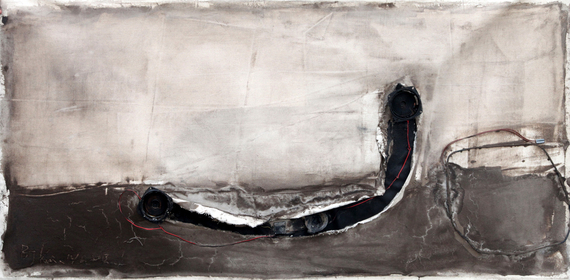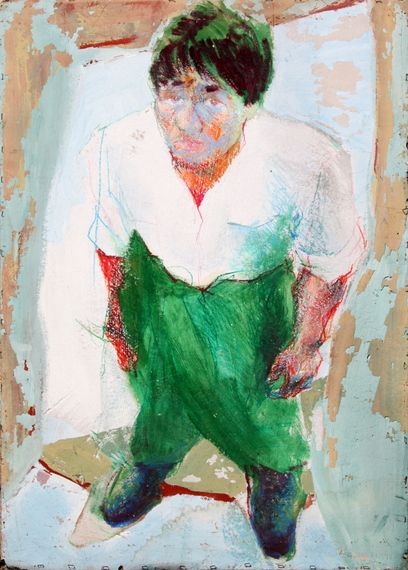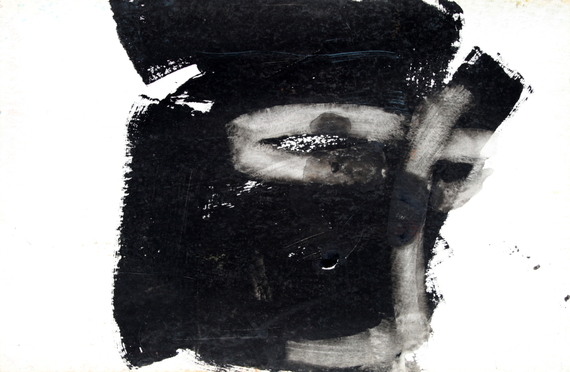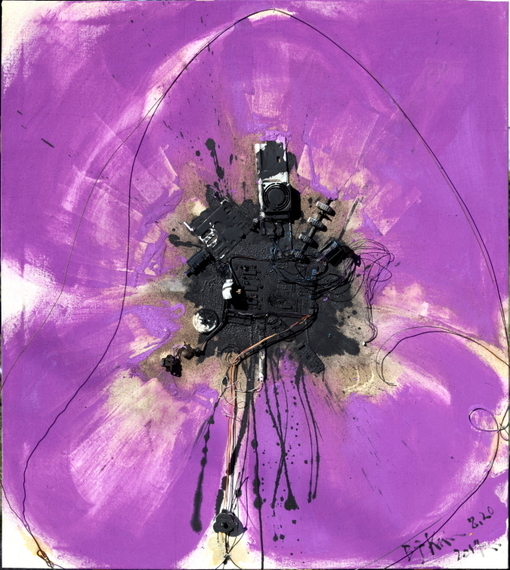Bong Jung Kim has a very deliberate and consistent way of working. His intention, which is navigated through bold combinations and contentious juxtapositions of symbols, mixes metaphors as he vies for a deeper cord in our psyches. He is primal with respect to color and technique, yet he tells his tale with references to the darker side of the collective contemporary social condition and our quick to throw away and ever-upgrading technology.
To help unravel Bong Jung Kim's iconography, I posed a few questions that I hope will get to the heart of his content.
DDL: Let's begin with some of your earliest works, images of your studio and your various subjects and self-portraits executed in the '80s. These, in many ways, are the most conventional with respect to media, technique and representation. Yet, despite those rather familiar elements you still managed to represent the figure as more than just a physical being. The Self Portrait series, the ones that have you looking directly up at the viewer has the same emotional impact I see in your more iconic later works. Can you tell me about the state of mind you are intending to project to your audience in those distinctive self-portraits?
BJK: My pictures show the status of my inner mind that has been oppressed not to show sexual desires that may result in unpleasant interpersonal relationships socially. Pretending to be upright and have integrity -- they live inside my inner desires and reflect in opposite ways. Those two opposite inner desires echo my appearance through masks often represented as the theme.
My environment (home, community, workplace, church) are hidden in my soul to hide a stronger desire, the layers accumulates in my inner sense... a state of fear holds me over that I may not be able to control and keeps me captive.
DDL: I see. It is your Mask series that's a more true representation of your persona or self-image. We all have our public and private sides but for you, there seems to be more of a struggle to represent the conflicted nature of the two -- to confess if you will -- a deeply tumultuous relationship. I can also see these masks as reflecting society in general, especially as public figures, as we all are a balancing reality and perception in this internet-dominated age. Is that where the use technology, as symbolized by computer components, comes into play?
BJK: Will my soul be free by removing electronic products from my life?
Even though I spend quite a bit of time with electronics/computer, I cannot say it makes my life more enriched. There is danger of losing much more as my mind becomes isolated and I lose touch with outside world. Our lives become separate. Our families, friends and neighbors all have been cut off by the barriers we build with our so-called convenient electronic devices, especially the walls be build around our hearts. We can laugh or smile at things we see on line but it is impossible to bring true joy through an electronic device. Every year, and with each ensuing series of work I create you will see and feel more and more of this isolation.
So, what can move my heart? To resolve this, I continue to dissect electronic products, disassembling them, pulling them apart and spreading the complicated parts out on my studio table, then finally revealing them on canvas to show their true self.
Currently, the symbol of the poppy flower covers my canvases. As I watch this process unfold, I was actually thinking about the look of these modern-day monsters as the ultimate symbol of addiction.
DDL: If the poppy flower represents addiction and isolation, what does the placement of the disassembled technology parts over a woman's genitalia represent? I suspect that is a reference to addiction as well, especially if you look at your mixed media titles.
BJK: Since childhood, my curiosity for women has grown. I can remember 26 years ago, when the Exhibition Review Committee in my college prohibited me from showing work that focused on women due to the overt sexual content. I found this very frustrating.
Today, it is much easier to find images of women, or to be in contact with women on the Internet. In the midst of all these many pictures of women you can see the image of the genitalia. By dismantling the computer parts, parts which I add to a women's genitals, I can enhance their representation as an addiction. If I place the computer parts over the eyeholes of the self-portrait masks I can present that view or portal of the addiction. This shows what my eyes are longing for.
Hence, the use of the complex components of the computer shows the state of my mind. It shows my addiction to the Internet, which in turn, symbolizes the complicated state of my mind -- which is a representation of the state of my consciousness and my longing for female genitalia.
This is why the female genitals can be combined with the symbol of the poppy flower - essentially, it's all about the addiction.





